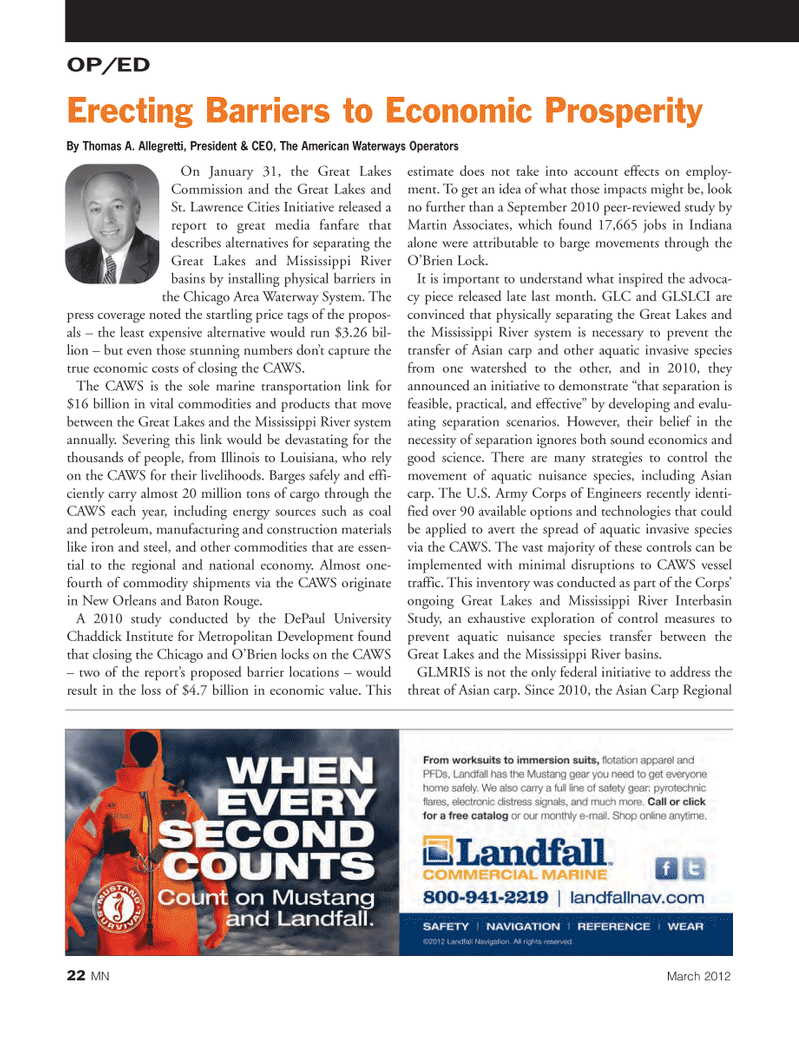
Page 22: of Marine News Magazine (March 2012)
Training & Education
Read this page in Pdf, Flash or Html5 edition of March 2012 Marine News Magazine
22MNMarch 2012On January 31, the Great Lakes Commission and the Great Lakes and St. Lawrence Cities Initiative released a report to great media fanfare that describes alternatives for separating the Great Lakes and Mississippi River basins by installing physical barriers in the Chicago Area Waterway System. The press coverage noted the startling price tags of the propos- als ? the least expensive alternative would run $3.26 bil- lion ? but even those stunning numbers don?t capture the true economic costs of closing the CAWS. The CAWS is the sole marine transportation link for $16 billion in vital commodities and products that move between the Great Lakes and the Mississippi River system annually. Severing this link would be devastating for the thousands of people, from Illinois to Louisiana, who rely on the CAWS for their livelihoods. Barges safely and effi- ciently carry almost 20 million tons of cargo through the CAWS each year, including energy sources such as coal and petroleum, manufacturing and construction materials like iron and steel, and other commodities that are essen- tial to the regional and national economy. Almost one- fourth of commodity shipments via the CAWS originate in New Orleans and Baton Rouge. A 2010 study conducted by the DePaul University Chaddick Institute for Metropolitan Development found that closing the Chicago and O?Brien locks on the CAWS ? two of the report?s proposed barrier locations ? would result in the loss of $4.7 billion in economic value. This estimate does not take into account effects on employ- ment. To get an idea of what those impacts might be, look no further than a September 2010 peer-reviewed study by Martin Associates, which found 17,665 jobs in Indiana alone were attributable to barge movements through the O?Brien Lock. It is important to understand what inspired the advoca- cy piece released late last month. GLC and GLSLCI are convinced that physically separating the Great Lakes and the Mississippi River system is necessary to prevent the transfer of Asian carp and other aquatic invasive species from one watershed to the other, and in 2010, they announced an initiative to demonstrate ?that separation is feasible, practical, and effective? by developing and evalu- ating separation scenarios. However, their belief in the necessity of separation ignores both sound economics and good science. There are many strategies to control the movement of aquatic nuisance species, including Asian carp. The U.S. Army Corps of Engineers recently identi- fied over 90 available options and technologies that could be applied to avert the spread of aquatic invasive species via the CAWS. The vast majority of these controls can be implemented with minimal disruptions to CAWS vessel traffic. This inventory was conducted as part of the Corps? ongoing Great Lakes and Mississippi River Interbasin Study, an exhaustive exploration of control measures to prevent aquatic nuisance species transfer between the Great Lakes and the Mississippi River basins. GLMRIS is not the only federal initiative to address the threat of Asian carp. Since 2010, the Asian Carp Regional OP/EDErecting Barriers to Economic Prosperity By Thomas A. Allegretti, President & CEO, The American Waterways Operators MN#3 (18-31):MN 2011 Layouts 3/2/2012 9:28 AM Page 22

 21
21

 23
23
